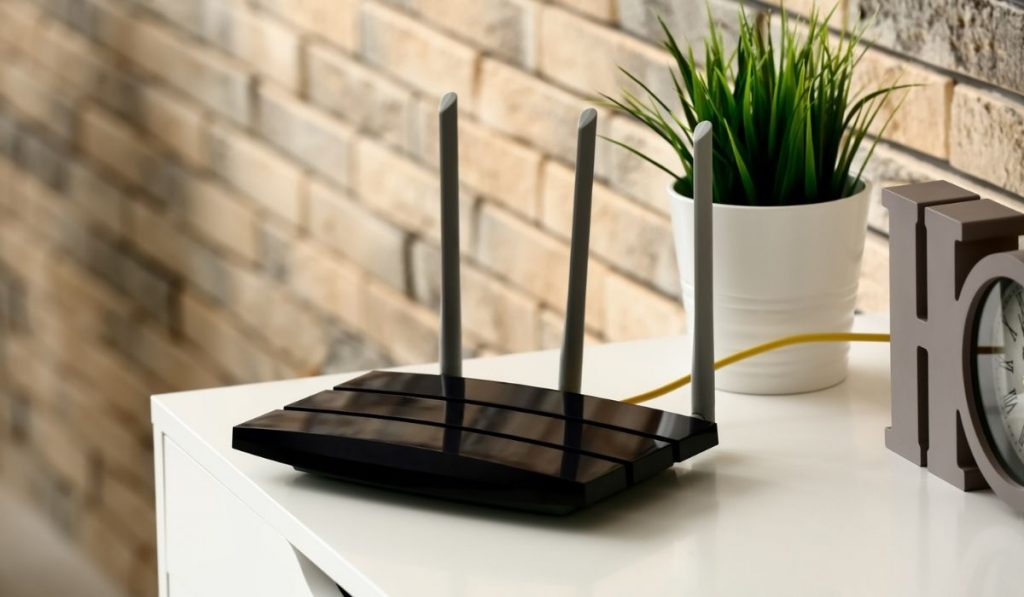It is okay to wonder how does WiFi go through walls because not everyone knows how the wavelengths travel in space. Not everyone knows the difference between WiFi and light wavelengths, so let us explain this.
It is essential to distinguish the wavelengths that can go through different barriers in space and the ones that reflect when they fall on a reflective surface. More straightforwardly, the light’s waves can go through transparent surfaces like glass but reflect on solids like walls, while the WiFi wavelengths are much bigger and invisible and can travel through walls.
Anyway, the WiFi signals can not pass through solid barriers completely. Part of the waves is not passing through, which is why the Wifi connection weakens as you go from room to room and further than your router.

How Does WiFi Go Through Walls
The WiFi router emits radio waves of 2.4 GHz and 5 GHz, which are more extensive than visible light waves. The size of a wave emitted by the WiFi allows the waves to pass through walls, but not entirely. They fade as they travel, which explains why some rooms’ internet connection is weaker than others based on their proximity to the router.
How do WiFi waves travel
Radio waves are the most expansive waves that can travel far and through. WiFi emits waves that belong in the radio waves range, which is why the walls are not an obstacle for you to have a steady WiFi connection in other rooms different than the one your router is at.
The walls are transparent for the WiFi waves, as the glass is transparent for the light waves. Radio waves can penetrate through solid walls up to a specific point. If the specific wall is too thick and made of strong solid materials, the WiFi might not pass through it.
Regular walls are thinner, and the WiFi can travel through them, which is why you have a connection in every room in your home. But, you might have noticed that the connection gets slower as you go further from the router.
The WiFi waves lose their strength as they pass through walls. This is known as attenuation. The wave passage is incomplete or attenuated because only part of the wave can go through a solid obstacle.
What affects the WiFi signal?
It is essential to know the material of which the wall is made. Some solid materials might reflect the WiFi signals and disrupt the internet connection when you enter from one room to another. Let’s discuss the factors that might affect the WiFi signal.
The wall material
Some dense building materials might obstruct the WiFi signals from passing through walls, while others might just reflect the signals and stop them from passing through. This is the case with wood and metal walls. Wood is a dense material that hardens the WiFi signal passage, while metal just reflects the signals in the opposite direction.
Drywall and porous walls never make an issue. Their texture and low density allow the signals to pass without slowing or fading them down.
Stored things around the wall
If you have stored some things on or close to the wall, it might be why you have a low WiFi connection in that room. Your clothes stored in the closet or wardrobe might be a barrier to the WiFi signals because they are a kind of blockage for the WiFi.
Your clothes would not stop the WiFi signals from entering your room, but they will make the signals fade.
Read more: How Does Wi-Fi Signal Travel
Objects in your home
Furniture and some bigger appliances might also be a reason for your poor WiFi connection. Appliances like dishwashers, microwave ovens, and refrigerators might block the WiFi signal if placed near the router.
Also, some furniture pieces made of dense materials like wood might block the router and disrupt the WiFi connection in other rooms.
Router blockage
It is okay to put the router in a less visible place, but you have to remember that anything might be a barrier that stops the WiFi signals from traveling freely. As we mentioned, there should not be dense wood or metal furniture around the router because these materials block the signals that the router emits.
Improve the WiFi signal
We believe you now understand how WiFi travels through walls and different materials. Knowing which materials let the signals pass through and which block the WiFi will help you find a way to improve the WiFi signal in your home.
If you notice a poor WiFi signal, try pointing the router’s antennas toward the room where you have WiFi issues. This will not drastically improve the situation, but it should give a better signal concentration in that direction.
Secondly, replace the plants (if any) between your router and your device. Plants and trees have solid wood that might disrupt the WiFi signal in some parts of your home. Ensure nothing close to the router might reflect its signals in the opposite direction or block them.
In the end, you can boost the WiFi signals by adding a WiFi booster (extender device). This device will simplify the work of your router and let you have a steady WiFi connection in every single room of your home. The Netgear extender is one of the highest-rated inexpensive WiFi extenders on the market.
Also read: How to Check Wifi Signal Strength
Conclusion
So, you have a stable WiFi connection in every room at home because the router emits WiFi signals with a radio frequency. You do not have to be a master in Physics because it is not that hard to understand how different signals travel in space.
We would be happy if our article helped you learn how does WiFi go through walls and how to improve the WiFi connection if you face some issues.